A trio of townhouses on 96th Street near Central Park West are in the process of being demolished, with the middle one already substantially gone. One of the townhouses was built in 1900, while the other two were constructed in 1926, according to Streeteasy.
The townhouses were purchased by Sackman Enterprises, which plans to build a new 22-story condo development on the site after the demolition. While the South side of 96th Street is in a protected historic district, the North side is not.
There is expected to be a community facility at the bottom of the development, along with 16 condo apartments that will be about 3,000 square feet on average. Despite the height, the development will actually result in a net loss of apartments in the neighborhood — the townhouses formerly had about 30 apartments.
Here’s what they looked like prior to demolition.
Here’s the rendering of what the new development is expected to look like.



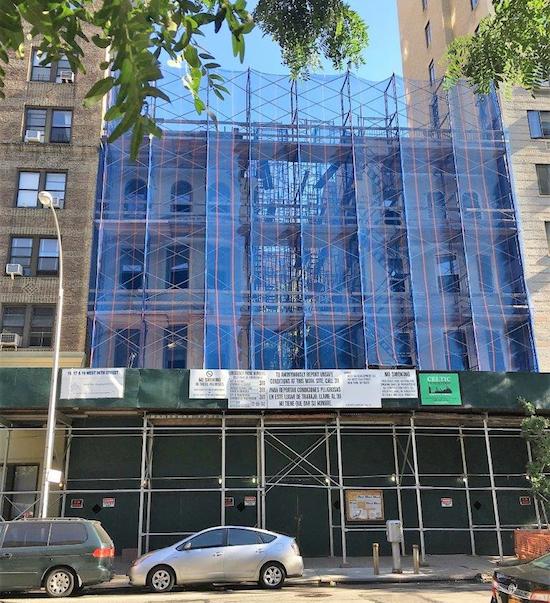
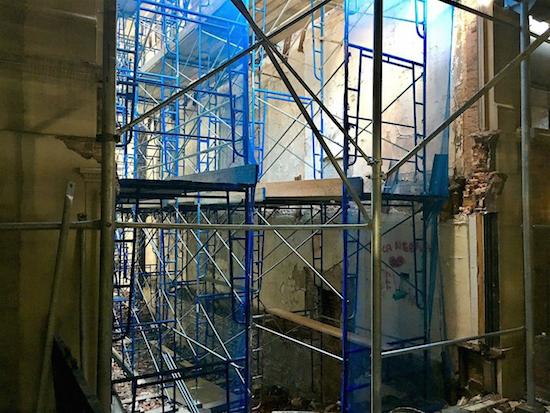
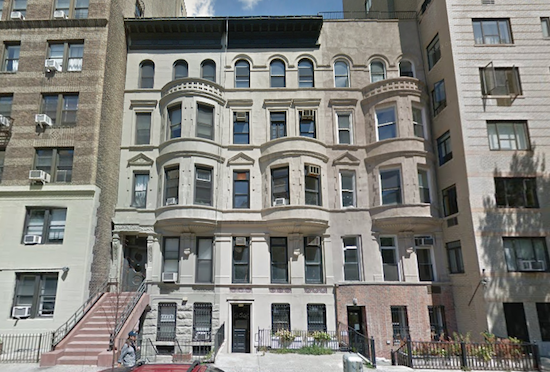
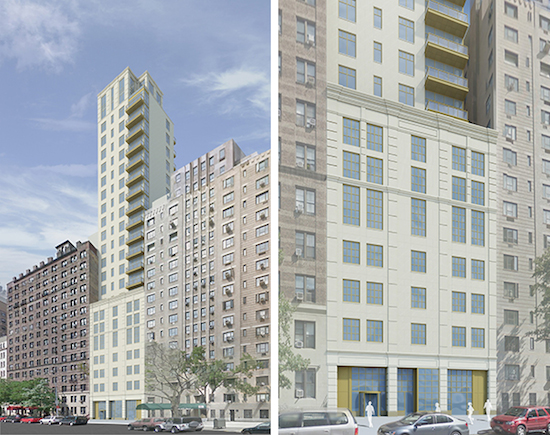





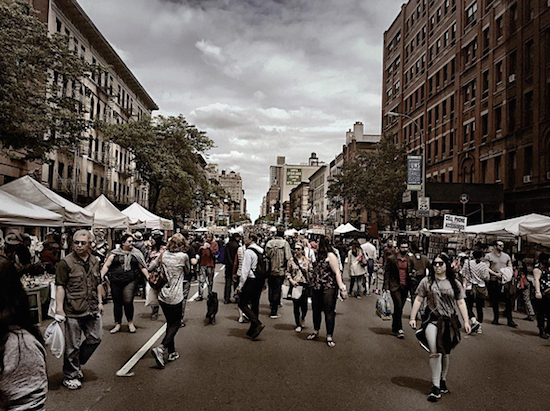
The new construction will hardly be a great addition to the neighborhood– just what we need: more luxury housing!– but I have to say those three building were in a pretty bad state of disrepair.
Isn’t the solution to the housing problem to build more housing? I don’t understand the vitriol that people have to “luxury” apartments. The fact of the matter is that people with money can and will buy whatever they want. If there isn’t “luxury” stock for them to buy, then they simply buy smaller apartments and combine them. By building “luxury” units it leaves the smaller units for those with less money to buy. The “luxury” developments also allow developers to build “affordable” units as well. It’s a win win.
How is tearing down a building in disrepair and is wasting space and replacing it with a 22-story development of new housing a negative for the neighborhood? Seems like a positive to me…
Well it would be a *positive* if local UWS or even many native New York City residents could afford to live in this (or any) new development. But the reality is normally that just isn’t possible. High land and other costs all but assure that any project built “as of right” is going to be luxury or at least skewed towards UMC.
Look up the average median income for that part of UWS, then crunch the numbers: https://project.wnyc.org/median-income-nabes/
Almost EVERY new development pushes out current residents to make a place for recent arrivals.
That is displacement.
someone i knew who moved up to Ct
It’s nice to know who has enjoyed your apartment before you moved in.
Provides a sense of continuity and community.
Who did you displace?
But this is a net destruction of housing units. The historic townhouses had 30 apartments. The tower will have 16 luxury condominiums.
What I don’t understand is how preservationists pick and choose their battles. Why fight the condos in an empty church when historic townhouses fall around the corner?
Because the First Church of Christ Scientist was a designated landmark by the most distinguished architects of the Gilded Age, Carrere & Hastings who also designed the NY Public Library and the Frick Collection. The condo plan for this space was a square peg in a round hole which did not meet the zoning regulations required by the city and was turned down by the Board of Standards & Appeals and the Community Board.
Unfortunately because of arbitrary laws in NY, the 3 brownstones which are historic and distinctive were NOT landmarked, in this case by virtue of being on the wrong side of the street. Also, no one ever applied to make them designated landmarks. It is hard enough for preservation groups to protect landmarks which are designated, (as in the case of the church) let alone those which are not. That’s where it takes the serious involvement of the community which is lacking. The city’s priority is not protecting landmarks, or despite lots of posturing from City Hall committed to lower or middle income housing. The developers are the driving force behind everything which is built or converted and they are motivated by money and money only. Sadly they support our major and minor politicians with massive amounts of campaign money which is why the Mayor is caught in a very serious “pay to play” scandal. Look around you-little is being built that does not start at $3000 a square foot. Developers have combed these streets and know exactly what they can take down with little resistance. They don’t care if they are building very expensive apartments replacing more middle income ones there before. They would mow down Grand Central if they could-oh, right-they already tried that. What’s sad is how many will run to Europe to delight in the magnificent many centuries old cities like Paris or Vienna while taking the axe to the historic fabric of New York. It’s beginning to resemble Germany after the war where new buildings have replaced the historic footprint. But there it was destroyed by war. Here it’s taken down at will with no planning or forethought. If you want to do something about it join your local preservation groups and get active.
Because we need AFFORDABLE not luxury!
Who is this ‘we’ of which you speak?
“Affordable” is a buzz word for housing for those with zero to almost no income. Those developments do little for hard working middle class people who have actual incomes but can’t afford million dollar+ housing.
Let’s see real development of housing for the middle class.
townhouses built in 1900 and 1926 are not a waste of space. they are, in fact, historic buildings.
Also, when you write “The fact of the matter is that people with money can and will buy whatever they want.” is that really true?
Explain to me how that statement is wrong.
As proof have you been on the housing market in recent years? My wife and I are lucky enough to be able to afford a modest one bedroom but needed a mortgage. Whenever we found anything on the market worth putting a bid on people would swoop in with all-cash deals and essentially close on the spot. We were lucky enough to finally find a unit pre-market with an owner who was willing to negotiate with us.
The more housing on the market, the better.
OK, i agree with you that “The fact of the matter is that people with money can and will buy whatever they want.”
sleep well tonight, i know i will having been so agreeable
Not everything that’s old is worthy of historic protection. 96th Street is a major crosstown street. Being a wide street it’s appropriate to build taller here.
don’t want to answer the question in your reply?
funny, because it is your quote
“but I have to say those three building were in a pretty bad state of disrepair”
wouldn’t you think that the solution to the ‘bad state of disrepair’ of townhouses built in 1900 and 1926 might be repair?
Unfortunately when rent regulation laws exist landlords have either no funds to properly maintain their buildings or no economic incentive to.
This benefits folks like dannyboy who live in rent controlled apartments but everybody else is stuck looking at decrepit eyesores.
So no, it’s not so easy to say that these old buildings simply need “repair”.
you should at least TRY to use the right terminology, Sherman. unless Dannyboy has been in the same apt since 1971, he doesn’t live in a “rent controlled” apt. his apt is “rent stabilized.” when you make this sort of mistake, it makes people think you might not know what you are talking about on other statements.
buildings that are entirely rent stabilized indeed do make $s (profits) for the landlords. the NYC Rent Guidelines Board has substantial public data if you care to look at it. they have to do a study of landlord income and expenses every year and publish it.
https://nycrgb.org/html/research/cresearch.html
DISCLAIMER: In the comment of mine that follows, I do not mean to imply any judgment on the validity or appropriateness of Sherman’s argument itself. Rather, I intend merely to expose and de-construct Bruce Bernstein’s attempt to undermine Sherman’s credibility. I certainly am NOT suggesting that I consider merely residing in a rent-regulated apartment (whether “control” OR “stabilization”) to be reprehensible or dishonorable.
How is the difference between rent control and rent stabilization material to Sherman’s point?
In the first sentence of his post, Sherman explicitly referred-to “rent regulation laws“, which obviously include both rent-stabilization and rent control.
This attempt of yours to discredit Sherman comes across as little more than petty pedantry. Considering your own failure to follow one of the most basic, universal rules of writing– capitalization of the beginning of a sentence…
(No reference-to any specific individual or party is to be inferred from the following.) But that is not all. Concerning rent control (as distinct from rent stabilization), you:
a) asserted that in order for one to presently be under rent control, one would have to be residing in the same apartment that one had occupied, continuously, since 1971 or earlier, and,
b) implied that such an occurrence was extremely rare
With a), you completely overlooked the possibility that someone could currently occupy a rent control apartment, entirely lawfully, through succession.
With b), you seem to have ignored the reality that although increasingly dwindling with the passage of time, there nonetheless still remain on the UWS a not-insignificant number of senior citizens who, under rent control, reside in apartments that they have occupied since 1971 or earlier.
The NYC Rent Guidlines Board is a pro-tenant – er, excuse me, pro rent-regulated tenant group.
As such, they’re not exactly a neutral and objective group.
Any “study” they prepared that proves how great rent regulation is for everyone should be taken with a grain of salt.
Please stop saying this lie.
I guess you can’t help yourself, though.
Must be your Nature.
New York Neighborhoods at Risk
https://www.nytimes.com/2016/09/22/nyregion/new-tool-shows-new-york-neighborhoods-at-risk-of-rent-hikes.html?rref=collection%2Fsectioncollection%2Fnyregion&action=click&contentCollection=nyregion®ion=stream&module=stream_unit&version=latest&contentPlacement=4&pgtype=sectionfront&_r=0
Note how the west-facing windows on the building at the right of the photo will be blocked by the new construction
Lot line windows are always in danger of blockage if the neighboring building has unused air rights. It is a risk of having those windows in the first place.
The buildings are beauties. This is a city of graft.
What an ugly monstrosity is the proposed building! The old building had beauty and grace and character; the new one is bland and entirely out of keeping with the area’s architectural character. The destruction of the UWS continues thanks to real estate greed and tastelessness and inept governance by the de Blasio administration.
Yet another unimaginative edifice jars the architectural integrity of the Upper West Side. Not opposed to new construction but I do advocate thoughtful design that enhances, not eliminates, a sense of place. Designs like this 22 story condo date quickly and add nothing aesthetically to the neighborhood.
I have heard grumbling from residents in the buildings both to the immediate right and left of the project. A whole slew of folks are losing their light (and home value).
What a pity with all the demolition and new construction going on throughout the City, New York is losing it’s character. It’s becoming a mishmosh of buildings without a design element or plan in mind or the effect on the residents living near the new construction. This is pure greed
Funny. I thought the constant change was part of New York City’s ‘character’.
A lot of people looking at the past through rose-colored glasses posting here. If you don’t want change, you should start buying real estate and let it sit empty. Pretty sure if you had enough to buy some real estate you’d be looking to sell it or develop it for top dollar.
Vile. Will the destruction of iconic buildings and affordable apartments never cease? What an ugly, uninspired piece of architectural crap.
I’m happy to see new development in the neighborhood but this building is as bland as they come. Not sure what’s up with those ugly utility-looking windows on the ground floor, but I do hope they put some commercial space there. Preferably a bar. I get thirsty walking those long stretches of 96th street on the way to Central Park!
What luxury market are these developers thinking that still exists in NYC? A lot of buyers were foreign investors and now China’s foreign currency reserves fell by $190 billion this year. I see the massive surge in buildings being converted to luxury in Long Island City and I just see this massive real estate crash incoming.
Very risky investment at the moment.
You can say that again. The recession has hit big in the over $5 million dollar category. Here’s where trickle down does work. We’re headed for a major slow down where many apartments will sit empty like so many storefront all over the UWS.
Not really.
First you have retail/community space on the first five floors. That will bring in something.
There is a shortage of new construction on the UWS of large apartments and these will be full floor units. For certain demographics obtaining a mortgage won’t be a problem so they can finance the purchase in whole or part.
You’ve got Central Park and the subway almost right outside the front door, so the location is perfect.
To be clear it is the uber luxury housing market in NYC that is suffering atm. There is still a sweet spot between “Billionaire’s Row” and 80/20 “affordable” housing.
Sweet, so maybe I’ll be able to afford to buy an apartment >400 square feet soon? Build, baby, build!
Despite what many of you think this is a great thing for the neighborhood and the city in general. The reality is that many of these old, unsafe and aesthetically unappealing buildings need to be demolished. End of story. The reach of the historic preservation agency or whatever is already ridiculous.
Be thankful that developers are willing to come into your neighborhood and spend millions of dollars. I know some of you like the old days of crime and rats and roaches, etc. but it’s over people. Progess moves on. I thought that you we progressives?? You get gift and gripe about it like spoiled children. (see the Museum expansion)
Sunrise, sunset. Out with the old in with the new. Build build build.
Your’e welcome.
Why can’t the developers refurbish the exterior of the buildings and renovate the inside with an acceptable amount of units, as opposed to cutting the number of units in half?
I’ve worked on the UES for 30+ years and I’ve heard UWSers complain for 30+ years about how horrible the UES is. The majority of the original brownstones AND tenements in the east 70’s through the 90’s are still intact, incorporating school spaces into the existing buildings, and they’ve been beautifully maintained on the outside and renovated on the inside. Why is tearing down brownstones on the UWS considered PROGRESS?
Also, have you seriously seen rats?
UWS and UES are two totally demographics which influenced development.
IIRC the UES for instance did not have large parts declared blighted and thus ripe for “urban renewal”. OTOH on the West Side from Hell’s Kitchen to around 100th Street is another story.
As the wealthy abandoned town house living for apartments yes, many were torn down to build multi-family housing. From Fifth to Lexington or even Third Avenues there are plenty of “new” buildings that replaced row houses or mansions. You can see evidence of this by the few remaining of the latter sandwiched between taller buildings.
Park Avenue is a bit different in that you didn’t get large scale construction of apartment buildings until the 1920’s. This was after New York Central RR covered over their tracks between 47th and 97th Streets.
What “saved” large parts of the UES/Yorkville actually was lack of subway access, and the fact EL trains along Third and Second Avenues. The Third Avenue El began shutting down only in 1950 and wasn’t completed until 1973.
All this coupled with white flight and economic downturn of NYC from the 1970’s really off and on until now meant there was little incentive to tear down large numbers of town houses. That has changed with the pending arrival of the SAS and new found wealth pouring into Manhattan.
Developers are grabbing up low rise/town houses all over the UES to build new luxury housing. https://ny.curbed.com/maps/the-old-upper-east-sides-new-development-boom-mapped
Where they aren’t buying to tear down, money is pouring into townhouses or mansions that once housed schools, non-profits or whatever and turning them back into private homes. Mind you a good part of the latter is for buildings in historic districts and or are landmarked, thus couldn’t be torn down regardless.
“Where they aren’t buying to tear down, money is pouring into townhouses or mansions that once housed schools, non-profits or whatever and turning them back into private homes.”
Remember St Vincents
You think somebody is thanking you for saying:
“End of story.” terminating the discussion.
“I know some of you like the old days of crime and rats and roaches” to demean the commenters.
“You get gift and gripe about it like spoiled children.” to insult your neighbors.
So those people in the existing apartment buildings that formerly HAD windows, no longer HAVE windows, now that the new building is going up. How convenient.
Losing one’s views is nothing new, has been happening for years.
If you are a renter there isn’t much that can be done. Condo or co-op boards can possibly try to acquire adjacent property or at least the air rights to stop further development.
At least one developer of a new “luxury” Manhattan building purchased air rights going several blocks (cannot recall the building) to prevent future projects from taking away views.
If they bought they should have done their research on unused air rights. I’d never buy an apartment with Windows that could be lost (if I was attached to those windows).
+1
If you are making possibly the biggest investment of your life you should know exactly what you are buying.
If you have lot line windows and not next to a landmark, you are probably going to eventually lose them.
New isn’t better, Just UGLY in most cases! This is one of them.
Is too late to stop this! what about landmark status?
Pathetic! Another ugly building replaces our beautiful and dwindling history.
Those two town houses sat firmly within the northern most reach of the Upper West Side Urban Renewal Area (West 87th to West 97th from CPW to Amsterdam). The fact they remained long as they did after the others on that block were torn down is something.
Both properties were up for sale, and anyone with deep enough pockets (#19 sold for 12 million IIRC),could have purchased.
Can someone please translate IIRC into English? It’s been used here several times and I’m afraid I don’t have that codebook.
TVMIRAI!
[“Thanks very much, I really appreciate it.”]
IIRC= if I recall correctly
Other common Internet abbreviations include:
AFAICT: as far as I can tell
AFAIK: as far as I know
IMO: in my opinion
IMHO: in my humble opinion
IMNSHO: in my not-so-humble opinion
YMMV: your mileage may vary
IANAL: I am not a lawyer
SO: significant other
DS: dear son
DD: dear daughter
DH: dear husband
DW: dear wife
TYVM!
If I recall correctly
If
I
Recall or Remember
Correctly
More about the planned development:
https://therealdeal.com/2014/12/19/sackman-enterprises-goes-bigger-at-uws-development/
https://www.cityrealty.com/nyc/central-park-west/15-west-96th-street/11978
Obviously those views of Central Park from the highest floors will be the selling point for those units. Money from those units will probably make the rest of the development profitable, and indeed worth undertaking.
Those speaking about “wasted space” of the old townhouses to an extent do have a point.
The townhouses predate the Eighth Avenue subway line. One predates the IRT with the other (built in 1920)completed one year after that service began.
At that time the UWS/Harlem was still “the country” though the two new subway lines were rapidly changing the areas as they became more easily accessible. What also changed (though not sure when) was the zoning.
At some point the City wanted to encourage the growth of apartment houses and discourage private homes/row houses. In a city seemingly always short of housing row houses do not give the most bang for real estate bucks.
It is likely that entire block of West 96th once was row houses just as many other parts of Manhattan. https://en.wikipedia.org/wiki/96th_Street_(Manhattan)#/media/File:34-42_West_96th_Street.jpg
When zoning changes made apartment houses possible over the decades developers acquired property and tore down the old row houses and put up apartment buildings. These two row houses were the last holdovers.
WSR covered the sale and pending demolition. Fact that the properties can be developed “as of right” reinforces my theory that the zoning permits this sort of project.
https://www.westsiderag.com/2015/01/08/demolitions-eviction-battles-and-more-an-update-on-uws-development-projects
https://www.westsiderag.com/2015/01/08/demolitions-eviction-battles-and-more-an-update-on-uws-development-projects
“Those speaking about “wasted space” of the old townhouses to an extent do have a point…
“What also changed (though not sure when) was the zoning.
At some point the City wanted to encourage the growth of apartment houses and discourage private homes/row houses. In a city seemingly always short of housing row houses do not give the most bang for real estate bucks.”
well i read a lot about the benefits to developers and why a higher tax base would motivate politicians, but not so much about the people who live[d] in those buildings.
Has been years since read about the zoning changes but the purpose was clear. The City needed more housing (does it not ever?), and to encourage development of apartment buildings zoning was changed to favor them over private homes/row houses.
Not sure when this happened but think it was early in the prior century well after mod cons like elevators made taller buildings possible. If you think there is a housing shortage now, imagine NYC, in particular Manhattan with mostly nothing but five or six story walk-up apartment buildings.
The “benefit” came to those seeking housing which again seems always to be in short supply.
In this particular instance while not a tax break developer took advantage of zoning for a *bonus*.
“A community facility will occupy the first five floors of the future 15 West 96th Street, with the residential portion rising after another amenity floor and a setback. (The undefined community facility space, which the zoning code allows as a bonus on top of the base residential floor area ratio, appears to be largely intended to boost the height of the apartments and improve their views.) Except for the duplex penthouse, each residence will take up an entire floor.” (source; YIMBY)
B.B. you certainly are well informed on all things Real Estate!
Question about ““A community facility will occupy the first five floors of the future 15 West 96th Street”
is that resource something the WSR community might avail themselves?
I am hopeful to find “a convent or monastery to non-profit art gallery” there.
Now those are great additions to our neighborhood.
According to zoning regulations:
“Community Facility Use”
“A community facility use provides educational, health, recreational, religious or other essential services for the community it serves. Community facility uses are listed in Use Groups 3 and 4.”
Those use groups range from a convent or monastery to non-profit art gallery.
“Your guess is as good as mine.”
B.B. you are way too modest. You answered, in not too many words when you wrote:
“The other big question is who will own the commercial/community spaces… This leads me to assume whatever ‘community’ use will have to be vetted by those living in those luxury apartments.”
I figure that ‘commercial/community spaces’ ain’t for The Community, “Commercial” always trumps. and “use will have to be vetted by those living in those luxury apartments.” means they ain’t gonna do something “Community Minded”.
oh well. Sounded good for a second
Your guess is as good as mine. We shall all have to wait until the building goes up to see what the developer offers.
Sadly zoning regulations leave “community space” rather undefined IIRC. So there is no telling what will be offered.
The other big question is who will own the commercial/community spaces. Since the building is condo unless developer carves out and keeps the lower floors from the residential above, the future owners of building will likely control things. This leads me to assume whatever “community” use will have to be vetted by those living in those luxury apartments.
Just what we don’t need on the upper west side! Another ugly 22 story building with no character and does not blend in with the current structures. These realtors are killing NYC!
Ask the buyers of this new abomination why they want to live on the west side. They will probably tell you that one of the main reasons is the low scale, historic feel of the neighborhood. After enough of these ugly buildings replace the beautiful existing buildings, these people will probably move elsewhere because the west side will be sterile and uninteresting.
If it is of any consolation to you there are still a group of remaining townhouses on the south side of West 96th going down towards Columbus. As that part of street is within historic district they won’t be going anywhere any time soon.
As for the balance of your post there is still plenty of “low rise” housing on the UWS. It just happens to be on the streets, while the avenues and main cross streets long have given over to mostly larger buildings.
Case in point two of these townhouses were built in 1926. Four years later in 1930 #7 West 96th went up on lots 7-11 of that street. Across the street also in 1930 #12 West 96th went up on lots 10-20. To the left of this planned development #27 West 96th (lots 21-33 )went up in 1927!
Clearly even by the 1930’s the days of West 96th Street as one of low rise townhouses was coming to an end.
how about we enact a variance for developers on the UWS: You have to build 2x the number of units that you are taking away, and 30% of those units must be specifically for families making less than 200K, and an additional 10% for families making less than 40K (or some such middle and lower income mix).
This seems reasonable, and would create a boom without destroying property values of those of us that are already here.
That is what mandatory inclusionary housing should have been.
Wouldn’t work in this instance as the project is being done “as of right”. Developer needs nothing from NYC other than proper permits and so forth.
A real MIH plan would require all properties as of right with multiple dwelling units in a zoning district to be inclusionary. With the proper zoning rules in place, a new as of right building would have to provide a place for displaced residents. On the UWS our elected officials opted to protect property owners interests rather than solve the housing problem.
Three architecturally interesting buildings replaced by one dull-looking, too-tall lump. Too bad the north side of 96th St is not also part of protected historic district – this might have protected our neighborhood from this drab pile of glass and concrete…
You’ve got Park West Village one block north. Can’t get much uglier than that, so I consider this an improvement to the neighborhood.t
Those buildings were falling apart.
With the rent guidelines board approving zero percent rent increases, how is anybody supposed to keep their buildings in good repair?
What a shame to demolish these gracious old buildings — to be replaced by an ugly, anonymous, flat box.
FYI: be skeptical of overly-supportive commentary on here for this and other projects. The WSR comment sections are known places of trolling by real estate developers/agents.
“Trolling”?
A troll is someone who makes incendiary posts just for the sake of provoking the expected reaction and then sits back and watches as the fur flies.
What you apparently meant is shilling.
What is the basis for your allegation that RE developers and agents regularly shill here? Care to cite any evidence or otherwise elaborate?
Yes, because it just isn’t possible that UWS residents NOT associated with the real estate industry could support a new development on the basis that it might actually breathe a little life into our stodgy old neighborhood. Sheeesh!
By the way, while the result is a net loss of units, it will probably be a net gain of residents as presumably there will be families moving into these larger apartments.
ya’ think?
You can’t save everybody….
In case it escaped notice this demolition is taking place just down the block from First Church of Christ at 361 CPW, the place everyone fought so hard to “save”.
Well because that structure is so low compared to modern surrounding buildings including 7 West 96 it allowed Sackman to build something near mid block that will have Central Park views from the highest floors.
In an ironic twist of fate because the said church is landmarked there is nil chance of whomever purchases the duplex penthouse will ever lose their views of Central Park.
Always amazes me that even outside historic districts NYC developers don’t keep and restore the original facade. It’s a common development approach in London. The facade remains and the new building goes up (and up) behind. Preserves and enhances the street level. Often adds value to the new development.
This low cost slab of a curtain wall is just fugly.
Form follows function. The old facades have no relation to the requirements of the interior of the new building. The shape of the building is also determined by zoning and building codes. The only thing that the designer can do is try to mimic the surrounding buildings in material and color. The renderings do not show any great detail or appointments. The developer of the building may have their own ideas as to what is trendy or what fits into the budget. The adjacent buildings are not notable in design or aesthetics. The surrounding neighborhood does have some architectural appeal but the general environment of transit, parks, schools, shopping, dining and other amenities remains the same. In the end the buyer is going to look inside the building to get the most value from the purchase.
“The developer of the building may have their own ideas as to what is trendy or what fits into the budget… In the end the buyer is going to look inside the building to get the most value from the purchase.”
Nice for the Developer and that person from who-knows-where, but aren’t there any other constituents?
There goes the neighborhood
I grew up in a small town in the midwest that underwent a major renovation in the 70’s to make it appear more modern. I went back this summer and discovered that those renovations were literally placed on top of the original facades and they were recently painstakingly removed to reveal the original facades. The downtown area now looks like it did in the logging era and the buildings resemble NYC brownstones and they’re absolutely amazing. If the UWS becomes too cookie cutter I may have to move back there. 😉
If life gives you a cookie-cutter, make cookies.
In your analogy, “Life” did not give us cookie-cutters.
Rather, the Developers went into our kitchen, stole every other kitchen utensil we had, and replaced them with that cookie-cutter.
Thx.
Can you also consider other options to:
“Also, concerning the planned new construction, I note that Paul RL wrote,
while the result is a net loss of units, it will probably be a net gain of residents as presumably there will be families moving into these larger apartments.
Is that not a legitimate argument in favor of a project such as this?”
Why does all additional additional housing require taller and taller buildings? Why does the additional housing need to be in Manhattan?
My above comment (“If life gives you a cookie-cutter…”) was not meant as any kind of serious response* to any of what HelenD wrote. Rather, her reference to a “cookie cutter” simply brought to mind for me the old saw “If life gives you lemons, then make lemonade!” and my comment was simply an adaptation of that.
(*Unusual for me, as I generally put much thought into each post I make here, considering each word carefully before finally submitting for moderator approval. But I’m not above sometimes resorting-to clichés, memes and other vices. Everyone’s entitled to such indulgences sometimes.)
As it happens, I am sympathetic to the sentiments that HelenD (as well as any number of others) expressed. I am always struck by the contrast between old and new buildings in the city: the beauty; character; often exquisite workmanship and detail; solidness and sturdiness that characterize so many of the older buildings are all conspicuously lacking in the newer ones. The latter, at least by comparison, often appear flimsy, soulless and even downright ugly.
Having said that, I do not know what would have been involved in renovating the current structures in-question; how practical it would be to do so and all of the various implications, complications and other considerations that were likely to be a factor in this and similar cases.
Also, concerning the planned new construction, I note that Paul RL wrote,
Is that not a legitimate argument in favor of a project such as this?
As for the general sentiment, often expressed in comments at WSR, that with chain stores, banks and newer buildings replacing the local “mom and pop” establishments and old architecture, the neighborhood has lost much of the special character it once had, let me address this briefly. As I have stated in past comments, I am sympathetic to this view and even, up to a point, share it myself. At the same time, however, I would hasten to add that the changes to the neighborhood have by no means been all bad and that the neighborhood of old was by no means all sweetness and light; there were many decidedly less-than-positive aspects of it that no sane person could wax nostalgic about. I elaborate upon these themes in this recent comment of mine, in which I recall a number of specific negative memories that I have from the neighborhood when I was growing-up here.
HelenD,
can you share your secret “small town in the midwest”?
Facades are often kept, but yes it does seem only within historic districts.
Just ten blocks south at 272 West 86th for instance:
https://www.westsiderag.com/2015/07/01/open-thread-wednesday-sometimes-this-neighborhood-feels-like-a-stage-set
https://272west86.com/
In contrast NYU kept the façade of St. Ann’s RC church on East 12th Street. It did them very little good really as people still complained.
“It did them very little good really as people still complained.”
it still did good
you can end your amazement
as there is no one representing the people of our neighborhood, the ‘original facades’ will be gone. Rather, expect more ‘low cost slabs of a curtain wall’